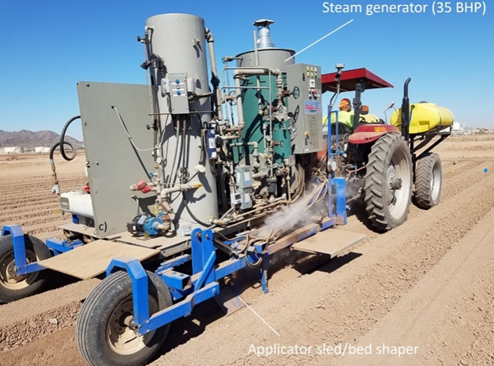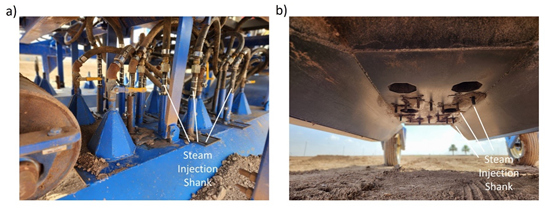Last month, we investigated the use of applying steam to the soil to control weeds in baby leaf spinach. In the study, we utilized the prototype steam applicator described in previous UA Veg IPM articles to inject steam into the soil prior to planting. The concept is to heat the soil to levels sufficient to kill soilborne pathogens and weed seeds (140 °F > 20 minutes). The device is principally comprised of a 35 BHP steam generator mounted on an elongated bed shaper (Fig. 1). The apparatus applies steam via shank injection and from cone shaped ports on top of the bed shaper. After cooling (<1 day), the crop is planted into the disinfested soil.
In the trial, the unit was configured so that one of the unit’s narrow-bed bed shapers (42” wide) was outfitted with fourteen steam injection shanks positioned to inject steam in the soil at a depth of about 2” (Fig. 2). Seven of the injectors were in a rank towards the front of the bed shaper with each injector spaced about 3.5” apart. A second rank of 7 injectors, also spaced 3.5” apart, was positioned in-line with the first rank towards the rear of the bed shaper. The steam applicator was underpowered to treat the entire 22” wide bedtop as the machine was designed to treat two, 4” wide bands of soil (8” total). As a consequence, travel speed was slow, 0.15 mph, to ensure target temperatures were met.
Results showed that steam treatment provided outstanding weed control of nearly 100% (Table 1, Fig. 3). The predominant species at the site were nettleleaf goosefoot and common purslane. This is a very impressive result however work rates were low (0.05 ac/hr) and fuel use/cost was high ($1,000/ac).
This was our first trial investigating the use of soil applied steam to control weeds in high density crops and think these operational parameters can be significantly improved. As stated previously, the unit was equipped with a steam generator with insufficient steam generation capacity. Equipping the device with a higher powered steam generator so that two beds can be treated at the same time would double the work rate. Also, steam was injected at a depth of 2” and at a travel speed was such that the amount of steam applied was adequate to control essentially all (100%) of the weeds. It is logical that shallower treatment depths and faster travel speeds could be utilized and still provide adequate control. Finally, it is estimated that travel speed can be at least doubled by operating the device when initial soil temperatures are high (>120 °F) as compared to this study where soil temperatures were relatively low (90 °F) since much less heat energy is needed to raise soil temperatures to target levels. If travel speed were doubled and two beds were treated during a pass, work rate would be improved to 0.21 ac/hr and fuel costs would be about $500/ac. These numbers are much more reasonable and show potential if high levels of weed control can be maintained. Over the next couple of months and throughout the summer, we plan to investigate these and other ways to improve the efficiency of steam application.
Acknowledgements
This work is supported by the Arizona Specialty Crop Block Grant Program and the Crop Production and Pest Management grant no. 2021-70006-35761 /project accession no. 1027435 from USDA-NIFA. We appreciate their support. Any opinions, findings, conclusions, or recommendations expressed in this publication are those of the author(s) and do not necessarily reflect the view of the U.S. Department of Agriculture.

Fig. 1. Band-steam applicator principally comprising a 35 BHP steam generator mounted on a bed-shaper applicator sled.

Fig. 2. Steam applicator sled a) top view and b) bottom view.
|
Table 1. Weed density and control with steam in baby leaf spinach trial. |
||
|
Treatment |
Weed Density |
Weed Control |
|
|
(#/ft2) |
(%) |
|
Steam |
0.05 |
99.4 |
|
Untreated |
8.23 |
--- |

Fig. 3. Weed control with steam in spinach. Steam was applied to the soil at a 2” depth via shank injection prior to planting (a) and untreated control (b).





